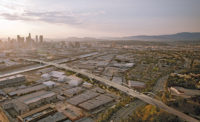Deck erection on the U.K.'s longest train viaduct formally started on May 31 with the launch of a 770-ton sliding girder that will place around 1,000 concrete elements along the 2.1-mile-long Colne Valley Viaduct on the emerging London-Birmingham high speed railroad, known as HS2.
First used nearly two decades ago on Hong Kong's 0.8-mile-long East Tsing Yi viaduct, the refurbished 525-ft-long launch girder will travel over the Colne Valley's 56 piers to erect the deck as balanced cantilevers, with approximately 150-, 200- and 260-ft spans.
The Align joint venture is building the viaduct across a series of lakes and waterways northwest of London under a $2-billion design-build contract covering 13.4 miles of the roughly 140-mile railroad. Align includes Align Bouygues Travaux Publics, Sir Robert McAlpine and VolkerFitzpatrick.
The viaduct is one of HS2's 300 sites with around 15,000 workers, Mark Thurston, CEO of the project company HS2 Ltd., said recently while briefing the U.K. parliament’s public accounts committee. Already 90% of the program's enabling works are done, with all civil construction set for completion in the next two years, he said.
Three of the program’s 10 tunnel boring machine are in operation, a fourth is due to start this summer and the rest will be launched over the next 12-to-18 months, Thurston added.
The HS2 project has just completed its first full year with $6.8 billion of work, and its spending rate is set to rise in the next few years, added Thurston. HS2 has a $56-billion total budget, including $12.5 billion in contingencies.
Some of those contingencies could be used to cover costs of the pandemic. Thurston put the direct pandemic costs at $126-190 million while indirect costs, still being negotiated with contractors, could add as much $500 million.
HS2's is also being hit by inflation at rates of nearly 80% for steel.
"You are seeing 30% to 40% swings in the cost of raw materials," Thurston said.
To control costs, HS2 is in "live debate" with its contractors over pooling their procurement efforts to concentrate their purchasing power, he added.








Post a comment to this article
Report Abusive Comment